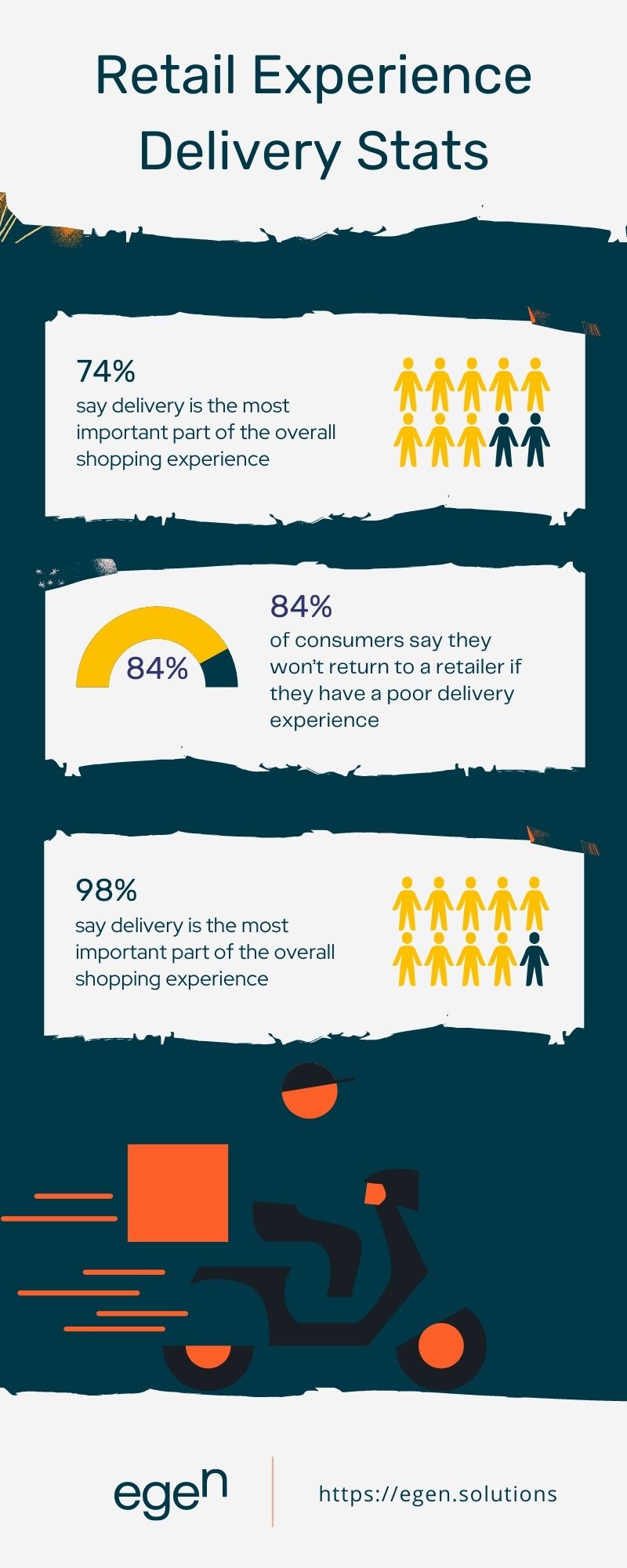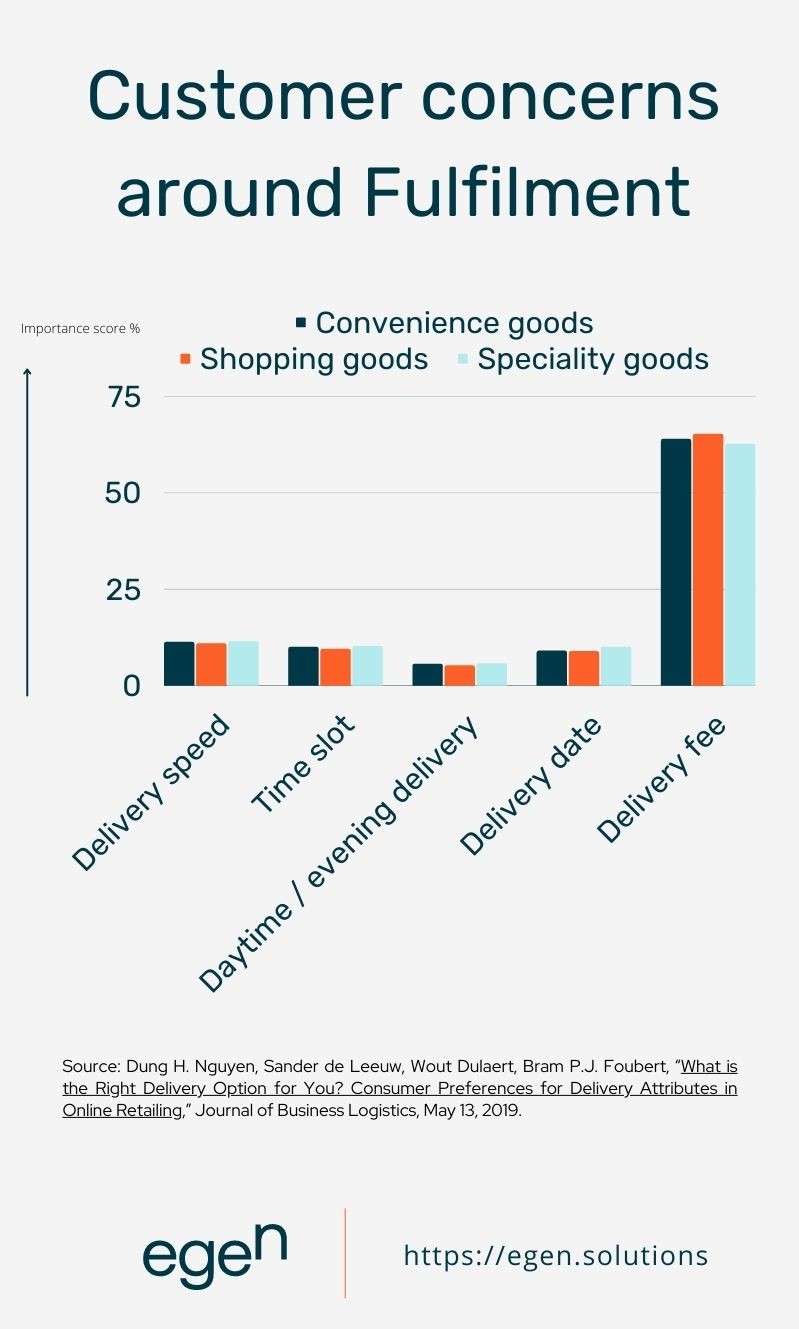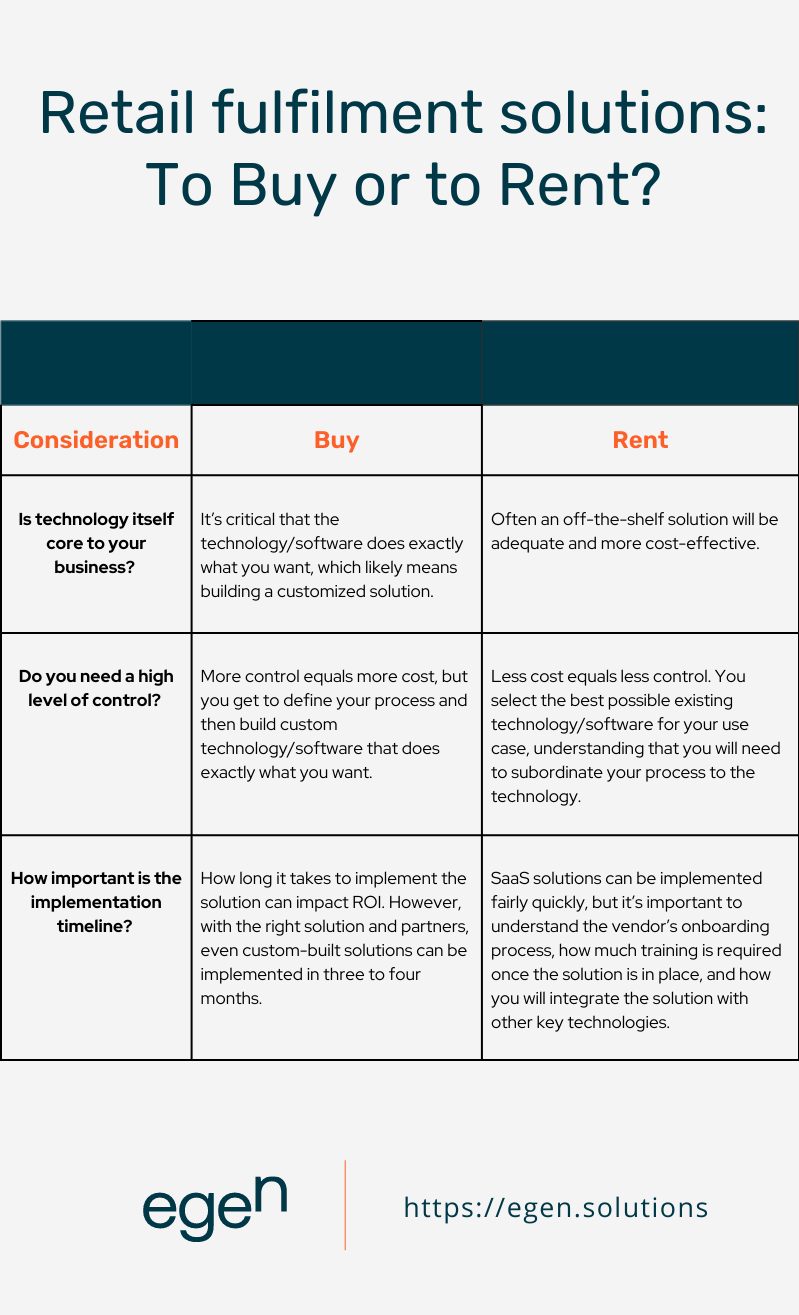
How to choose a Last Mile Logistics Solution: 5 Key Considerations
Does choice exist when you consider things very clearly? Read this deep dive to find out what factors influence last mile implementation
- 🗓️ Date:
- ⏱️ Time to read:
Table of Contents
In retail, the last mile is arguably the most important part of delivery operations. It is during this stage that there is a tactile experience of e-commerce as the customer receives the product.
74% of consumers report delivery is the most important part of the overall shopping experience. But that’s not all. 84% say they won’t return to a retailer if they have a poor delivery1 experience! What’s more? Almost all consumers (98%) agree that the delivery experience (good or bad) impacts their brand loyalty.
Yet despite its importance, many retailers have made little progress toward implementing the tools or processes to improve last-mile delivery and order fulfillment. According to a report, only 5% of companies’ current systems fully support efforts to improve the customer experience2.
There are several reasons why retailers struggle with last mile.
- It requires complex orchestration of inventory, supply chains, and third-party partnerships.
- It also needs appropriate setup and handling of technology and customer data.
- There is also the question of what approach to take to best connect all the pieces together. For instance - should one build, buy or rent the technology?
Faced with such major decisions, it often seems easier to grapple with point solutions to resolve one area at a time. But a piecemeal solution will not provide the seamless experience your customers demand.
You need a holistic approach.

COVID-19 has only expedited the rate at which consumers opt for online purchasing channels. In a post-pandemic world, getting the delivery experience right is crucial. It impacts not only the customer experience, but also brand loyalty and profits.
Customer expectations around fulfillment
When the first wave of COVID-19 hit, the world saw retail chains move seemingly overnight from in-store to online. Initially customers were patient, as businesses needed time to adjust. But once social distancing started to become the norm, customers have started to become less forgiving.
This is especially towards retailers who continue to struggle with having the right technology to support omnichannel delivery experiences. Fast and inexpensive delivery is now considered the norm, not the exception.
When it comes to fulfillment, there are three key areas customers care most about: convenience, speed, and cost. But as survey results from the Journal of Business Logistics show, the value of each isn’t equally important to customers3. Generally, when asked about the importance of cost, convenience, or speed, here’s how they rank:
- Cost wins out as being the most important delivery factor for consumers.
- Speed is next.
- Convenience factors, such as time slot and delivery time or date were least important. Still, they are considered a salient part of the overall delivery experience.

Convenience
Convenience is the primary reason why customers are opting for online channels. Besides, they’re even more likely to buy when this convenience is further improved through a streamlined fulfillment process.
Globally, 76% of consumers shop for groceries online because it enables them to shop at their own leisure. In the United States, it’s even higher - 81%4.
The added convenience of same-day delivery is also highly enticing. Nearly half (49%) of shoppers admit that the option for same-day delivery makes them more likely to shop online.
What’s more? Many are even willing to pay for this added convenience. Nearly 3 out of 4 consumers say they will spend more if they are satisfied with the delivery service.
Being able to choose a delivery time is another convenience many consumers want from retailers. In one study, 86% of consumers felt retailers should allow them to choose the most convenient delivery option at the time of ordering5.
Speed
Related to convenience, speed of fulfillment is especially important to consumers. Over half of consumers (55%) indicate they will switch to a competitor if that competitor offers a faster service. And 96% of shoppers consider “fast delivery” to mean same-day delivery6.
Same-day delivery
Convenience is in some sense associated with speed. 50% of consumers say the reason they use same-day delivery is because they need the order immediately. This may explain why many shoppers are even willing to pay more for same-day delivery.
Whether the reason for consumers wanting same day delivery is out of necessity or desire, it’s still a must-have for retailers. On average, nearly one-fourth (24%) of all shoppers will abandon an order, if same-day delivery isn’t an option.
Preferred windows
Timing matters too, just as much as speed. In many cases, delivering faster or before a customer’s preferred window is as bad as late delivery. Deliver too early, and no one may be available to receive the order. This in turn, increases the risk of theft, or spoilage if the shipment is perishable7.
Cost
Cost is almost always a top concern for customers. But when it comes to last-mile delivery, it’s also a significant concern for retailers. Delivery costs are one of the highest expenses in the entire supply chain.
While free delivery is extremely important to the customer, it’s never truly free. The cost - whether same-day, two-day, or standard shipping - must be charged somewhere along the line. It could be either as a membership fee, or rolled into the price of the product.
Unless the grocer bolsters their last-mile delivery capabilities, their net profit could potentially fall by 26% over three years. These numbers are based on an analysis of a hypothetical grocery retailer in the US.
So not only do retailers need to get the customer experience right, but they also need to be able to turn a profit and grow revenue. To complement growing customer expectations, you need an efficient and modernized order fulfillment solution.
Key considerations for a modern fulfillment solution
Many retailers assume that third-party partners can offer a path to last-mile delivery success while avoiding the need to invest heavily in technology. But relying solely on third-party e-commerce platforms like Instacart comes with significant risk and cost.
Whenever you outsource order fulfillment, you lose control of the customer experience. Although delivering the right products at the right time can sometimes be out of your hands, any errors will still reflect on your brand.
Costs can also rapidly escalate for you and for your customers. For example, every Instacart order includes an average 23% markup on online prices. Not only that, it also involves a minimum $5.99 delivery fee, a service fee, and the option for tipping the shopper.
Markups are also not consistent across partner stores. Your markup might be higher than those of your competitors. This increases the risk that customers will switch to your competitors.
If you want to control costs, profitability, and the customer experience, you can’t rely on third-party partners completely. Every retailer should have the capability to orchestrate last-mile delivery in-house. That involves five essential components:
Multiple delivery options
Customers need to be able to choose between delivery options like:
- Same-day delivery
- 2 day delivery
- BOPIS - Buy online, pick-up in store
- Curbside pick-up,
and so on.
Should one rely on 3rd party partners?
Not totally. At the same time, you do need to enable a variety of fulfillment options across multiple channels. that can integrate with third-party fulfillment services. This includes integrations with shipping providers like FedEx and UPS, and with delivery services like Instacart. If you don’t have your own fulfillment centers, third-party integration becomes even more essential to being able to offer multiple delivery options.
Real-time visibility
Along with fast, on-time delivery, a full 97% of customers also want to be able to monitor their orders8. This requires real-time visibility throughout the entire order fulfillment process.
This would mean knowing what inventory is at what warehouse, all the way to when an order is shipped, and then tracking that order until delivery too.
Automation
For grocers in particular, store picking can be highly inefficient and expensive. It can be done for far less via automation. This ultimately brings down costs and protects your margins. Here are some interesting strategies:
Micro-fulfillment centers
One prime opportunity for automation is Micro-fulfillment centers. For a large automated warehouse, these centers can be installed at much lower capital cost and in a few months, as opposed to a couple of years. Retailers, manufacturers, and distributors can all use these automated centers to reduce transportation costs and enable shorter delivery times.
Additionally, as demand for e-grocery services increases, micro-fulfillment centers allow grocers to move fulfillment closer to customers for curbside pickup or home delivery.
Micro-fulfillment centers can also easily store between 2 to 5 days of groceries. This enables an especially attractive option to pure-play e-grocers that don’t have retail stores to serve as fulfillment hubs.
AI Chatbots
Another area of automation worth exploring is AI chatbots. They can be especially useful in automating customer service.
Chatbots are 24/7 solutions that take the pressure off the store staff to deal with common customer questions or concerns. This enables a better customer experience while keeping costs down.
Optimized business model
As a retailer, what factors enable you to come up with winning product assortments that drive traffic and sales? Here are the most important ones:
- A thorough knowledge of your market and domain
- A deep understanding of your customers’ shopping habits
- Possessing sales and inventory data
- And finally, having the right set of technological tools
Additionally, providing supplemental products can take part in a larger marketplace. This way, you can provide a greater value proposition for your target customers.
Optimization with real-time data intelligence
Real-time intelligence allows you to update your inventory on a nearly instant basis, in the order of few 100 milliseconds. It achieves this by connecting all systems and applications across brick-and-mortar stores, e-commerce, and warehouses. And in turn, several segments of your order-fulfillment setup get augmented:
- Omnichannel experiences such as BOPIS or curbside delivery become seamless,
- Visibility on real-time stock availability,
- Increase in pass rates and fill rates of retail orders
- Enables enacting price changes in real time.
But in-order to set-up real time data intelligence, there are a few considerations to bear in mind:
- The order fulfillment solution will need to be able to centralize data sources. This means being able to ingest data in varying formats. Data also needs to be ingested from various ecosystems - such as partners in supply chains, internal data, etc.
- Deploying event streaming is also necessary to help you break down data silos and detect updates as soon as they happen.
How to select the right delivery orchestration solution
Now that you know what your delivery orchestration solution must enable, it’s time to determine which delivery orchestration solution will deliver the greatest value and the strongest return on investment (ROI).
Build, buy or rent
Given that the flexibility, scalability and speed of the cloud are all essential to successful omnichannel delivery services, the choice really comes down to two options.
- Do you build your own custom solution, either in-house or with the help of a partner? or
- Buy an on-premise solution or “rent” a SaaS solution as a subscription model?
To determine which path will be best based on the ROI, you will need to evaluate the following:

infographic - retail fulfillment solutions
Evaluating returns and outcomes
You need to know going in what outcomes you are trying to achieve, and what returns you think those outcomes will deliver. This comes down to understanding your business objectives and what is most critical to your business.
For instance, what is the primary objective? Is it to:
- Improve the customer experience?
- or increase automation?
- or improve operational efficiency?
Once you know what your desired outcomes are, you need to calculate the cost of the solution against those projected returns and outcomes. Having an awareness of KPIs and metrics to be tracked before, during, and after implementation will help you best determine the returns and projected outcomes.
Using a technology partner to help
It’s also important to consider how and where a partner can help. You might have determined that a SaaS solution makes the most sense for your business. But a technology partner may still be useful in providing critical expertise.
If you’ve chosen to build, a technology partner can be even more critical. No one has time to reinvent the wheel. Even technology companies can use help in a space where people have developed proven solutions.
A good technology partner will go the extra mile to get Last Mile right.
Retail giants like Amazon have proliferated the e-commerce landscape. So the question isn’t whether to invest in an orchestrated delivery solution, but how to get it right.
Faster, more flexible delivery is essential to the customer experience and remaining competitive. Postponing the modernization of last-mile omnichannel delivery has simply become too expensive. Retailers must invest in last-mile logistics solutions now.
The most critical element of modernizing for last-mile delivery will require a holistic approach. One that connects the entire supply chain process in the following ways:
- Having order and inventory visibility
- Delivery at the customer’s home or business
This can be done with technological interventions, that put in place:
- Real-time data capabilities,
- Event-streaming services,
- API integrations,
- Ability to support automation.
Finding a partner that has proven experience and can guide you through this process will not only ensure you get it right but also lower the cost of ownership. Here’s how:
- The right partner with the right expertise can identify areas where you can gain greater profitability. This would mean by making last-mile more efficient.
- They can also speed your implementation timeline,
- The right partner can also help guide you through onboarding and change management. This ensures that you are able to maximize your investment.
About Egen
At Egen, we work in tandem with some of the world’s largest retail giants to implement last mile logistic solutions. Our team of domain experts and cloud native data engineers can size up your challenges and work with you to determine a solution ahead of time.
If you’re into retail, let’s talk! Say hello ? at digital@egen.solutions.
-
Last Mile Delivery: What Shoppers Want and How to #SaveRetail ↩︎
-
The Perfect Order: Overcoming Roadblocks in Last Mile Delivery Experience ↩︎
-
“What is the Right Delivery Option for You? Consumer Preferences for Delivery Attributes in Online Retailing” - Journal of Business Logistics, May 13, 2019 ↩︎
-
The Last-Mile Delivery Challenge - Capgemini, 2019 ↩︎
-
13% of Shoppers Never Come Back If Their Delivery Isn’t on Time - Small Business Trends, Oct. 21, 2019 ↩︎
-
Kalid Saleh, “The Importance of Same Day Delivery-Statistics and Trends”, Invesp, April 11, 2020 ↩︎
-
“State of Retail Delivery & Fulfillment”, Bringg, January 2021. ↩︎
-
Kristina Lopienski, “Tracking Ecommerce Orders: Meeting Ever-Changing Customer Expectations”, ShipBob, May 2, 2019 ↩︎